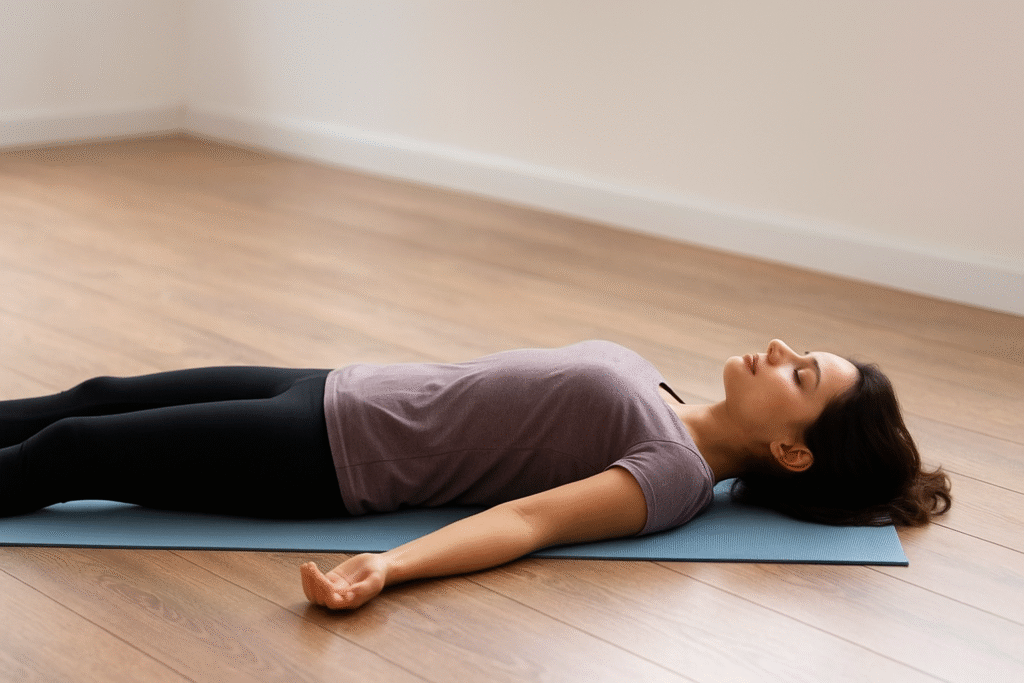Rx Yoga Nidra: 15 Minutes a Day
Amongst all the yogic practices, if I had to prescribe just one for our times, it would be Yoga Nidra. Think of it as your daily Rx—15 minutes a day × once a day dosage with no side effects, only healing. In a world where stress, sleeplessness, and constant busyness have become the new normal, this simple yet profound practice offers deep rest for the body, calm for the mind, and renewal for the spirit. A short daily dose is enough to reset your system and gradually transform the way you live, work, and relate to yourself.

What is Yoga Nidra?
Yoga Nidra, often called “yogic sleep,” is not ordinary sleep. It is a guided practice where you rest deeply while remaining aware. In just a few minutes, your body relaxes, your breath slows, and your mind shifts into a calm, healing state. It feels like a power nap for the body and a spa treatment for the nervous system—all while you’re simply lying down and listening.
Roots and the Difference from Sleep
Though Yoga Nidra feels restful like sleep, its roots lie deep in the traditions of classical Yoga and Tantra, where it was used as a doorway to inner awareness. The key difference from regular sleep is that in Yoga Nidra you are not unconscious—you remain gently aware, guided step by step into relaxation. Sleep restores the body, but Yoga Nidra restores both body and mind, giving access to a calm clarity that ordinary sleep rarely touches.
Why 15 Minutes Works
You don’t need an hour-long session to feel the benefits of Yoga Nidra. Just 15 minutes a day is enough to shift the body and mind into a deeply restorative state. Modern science shows that during Yoga Nidra, brainwaves naturally move from active beta into the calmer alpha and theta states—the same states linked to creativity, healing, and stress relief.
From an Ayurvedic view, this short practice soothes the overactive Vata and overheated Pitta, restoring balance to the nervous system. In yogic terms, it gives you a daily moment of pratyahara—turning the senses inward—which is like mental hygiene for our busy lives. Over time, this small daily reset brings more clarity, energy, and emotional steadiness into everything you do.
Benefits of a 15-Minute Daily Practice
Deep physical rest – releases muscle tension and lowers fatigue
Better sleep – calms the racing mind and reduces insomnia
Stress relief – shifts the nervous system into a relaxed, healing mode
Emotional balance – eases anxiety, irritability, and mood swings
Sharper focus – clears mental clutter and improves concentration
Inner reset – breaks repetitive thought patterns, creating space for fresh responses
Spiritual depth – offers a gentle doorway into meditation and self-awareness
🕉 Yoga Nidra and the Dissolving of Samskaras
In the yogic view, much of our stress, restlessness, and even suffering comes not only from today’s worries but from deep-seated samskaras—subtle impressions left behind by past experiences. These are like invisible imprints that quietly shape our habits, reactions, and even future destinies.
Yoga Nidra is unique among yogic practices because it brings us into a state between waking and sleep, where the mind becomes open and receptive. In this inner silence, samskaras can surface in their latent form and gradually dissolve, losing their grip on us. With consistent practice, Yoga Nidra can “clean the slate,” offering freedom from repetitive patterns of thought and action.
On the highest level, dissolving samskaras means loosening the very cycle of karma and rebirth, opening the way to inner liberation (moksha). Thus, what may appear as a simple relaxation practice also carries within it the profound power to transform the roots of suffering.
Note: A Simple, Beginner-Friendly Practice
This 15-minute guided practice focuses on deep relaxation and is designed to be easy and approachable for daily use. It does not include elements like sankalpa (personal intention setting) or chakra perception found in longer or more traditional forms of Yoga Nidra, but it offers the same calming benefits and can be a perfect introduction to the practice.
Your Daily Rx
Beginning a Yoga Nidra practice is simple—you only need a quiet space and the willingness to pause. The easiest way to experience it is to be guided by a teacher in a class or to listen to a recording, so you can simply relax and follow the voice.
If there’s one gentle prescription I’d love for you to try, it is this: 15 minutes of Yoga Nidra a day. Think of it as medicine for the mind and nourishment for the spirit—safe, effective, and deeply restorative.
I’ve recorded a 15-minute guided Yoga Nidra that you can follow anytime—morning, afternoon, or before sleep—your daily Rx for rest and renewal.
👉 Practice with me here on YouTube https://www.youtube.com/watch?v=fyTEFKOV4Dw&t=5s
📚 Research Insights on Yoga Nidra
For those interested in exploring the science behind Yoga Nidra, here are a few studies that highlight its benefits:
1. Improving Sleep and Cognitive Performance
A study published in Nature found that a two-week Yoga Nidra program significantly improved deep sleep quality and cognitive functions like attention, learning, and memory. It suggests that Yoga Nidra reduces sympathetic nervous system activity and enhances relaxation.
🔗 Read more here
2. Stress Management in the Workplace
Research published in Purushartha – A Journal of Management Ethics and Spirituality explored Yoga Nidra as an intervention for workplace stress. The findings showed that the practice helps in reducing stress and improving overall well-being.
🔗 Read more here
3. Effects of Short Yoga Nidra Meditation
A study in Current Psychology analyzed the impact of an 11-minute Yoga Nidra practice on stress, sleep, and well-being. The results indicated significant benefits, demonstrating that even short sessions can effectively support mental health.
🔗 Read more here
